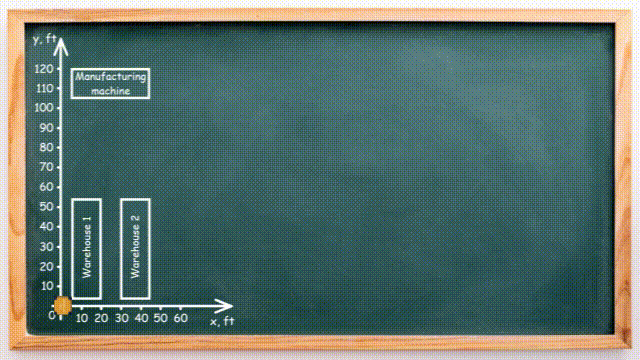Introduction
Absolute value of a number
In math, absolute value is the distance of a number from zero on the number line, no matter if it’s positive or negative. It’s always a non-negative number and helps us solve problems involving distance, size, and more. For example:
- The absolute value of −8 is 8.
- The absolute value of 3 is 3.
We write absolute value using vertical bars, like this: |x|, where x represents the number. So, |−8|=8 and |3|=3. This shows that absolute value focuses on distance, ignoring whether the number is positive or negative.
Application of absolute value in real life
Absolute value is used in many areas of everyday life. It helps measure distances, no matter the direction, which is important for things like navigation. In science, absolute value is used to describe changes in temperature or electric charges. It’s also used in finance to calculate changes in prices or deviations from expected values.
One interesting use of absolute value is in robotics. It helps calculate the distances traveled by warehouse robots and optimize their paths. Let’s take a closer look at this.
Example of application
Warehouses
A warehouse is a large building where goods and materials are stored until they are needed for manufacturing or sale. Warehouses are usually equipped with shelves, storage racks, and machinery to help organize and move items efficiently.

For decades, people worked in warehouses, picking items from shelves and delivering them to machines or sales areas. But things are changing, and today, robots are playing a bigger role in warehouses.
Warehouse robots
Warehouse robots are machines designed to move goods around in a warehouse. They can pick up, carry, and deliver items to different locations, making the process faster and more efficient. These robots use special mathematical algorithms to navigate and perform tasks. Some of these algorithms rely on the absolute value of a number. Let’s take a closer look.
Animated video
The next chapters will explain how warehouse robots use absolute value to calculate distances. It will be easier to follow along with our animated video, which includes a detailed explanation. Take a look at the preview below, and consider subscribing to get access to all our full videos about real-life math applications. (Why subscribe?)
Calculating warehouse robots distances using cartesian coordinates
When robots navigate between shelves in a warehouse, they often use mathematical coordinates. Take a look at the picture below. For example, a robot (shown as a small orange rectangle) might move from (0,0) to (50,50) to pick up a package, then deliver it to (10,100).

To plan efficiently, it’s important to calculate the distance the robot travels. But how do we calculate it?
Let’s break it down step by step. When the robot moves from (0,0) to (50,0), we can calculate the distance by subtracting the second coordinate from the first one, for both x and y:
- x: 50 – 0
- y: 0 – 0
So, the distance is 50 feet. Let’s do the same for the next part:
- From (50,0) to (50,50):
- x: 50 – 50
- y: 50 – 0
(Subtotal: 50 feet)
- From (50,50) to (50,100):
- x: 50 – 50
- y: 100 – 50
(Subtotal: 50 feet)
Problems arise when we try the same method to calculate the distance from (50,100) to (10,100). Subtracting the x-coordinates gives a negative result, leading to an incorrect total distance:
- x: 10 – 50 = -40
- y: 100 – 100
You may have already guessed that this is where using absolute value helps the algorithm work correctly.
Fixing the algorithm with absolute value
Let’s now re-calculate it for the x-coordinate using absolute value:
- x-coordinates: |10-50| = |-40| = 40
- y-coordinates: |100-100| = 0.
(Subtotal: 40 feet, Total: 50+50+50+40=190 feet)
By applying absolute value, we get a positive result for the x-coordinate, which corrects the earlier mistake. This approach ensures that the distance is always measured as a non-negative value, allowing the robot’s path to be calculated accurately. Using absolute value in this context helps avoid errors in the distance calculation, making the navigation process more reliable and efficient.
Manhattan distance or taxicab geometry
The method you’ve just seen is called “Manhattan geometry,” “Manhattan distance,” or “taxicab geometry.” It shows that when we move only vertically or horizontally on the coordinate plane, the distance between two points can be found by calculating the sum of the absolute values of the differences between the coordinates, like this:
|x₂ – x₁| + |y₂ – y₁|.
How math knowledge never outdates (conclusion)
The first mathematical works related to Manhattan distance date back to the 16th century, and in the 19th century, this method began to be used for calculating distances on the coordinate plane. Today, it’s still applied in many real-life fields, including artificial intelligence, finance, science, and more. As you can see, despite its age, this technique remains highly relevant.
There are many examples of mathematical knowledge, hundreds or even thousands of years old, still being used in the modern world. This shows that mathematical concepts never truly become outdated and continue to be valuable through the ages.
If you’d like to explore more on this topic and discover how math has been applied from ancient times to today, check out our article: Real-Life Math Applications: From Ancient Times to Today.
References
We always strive to provide accurate information to our readers. To ensure this, we have consulted the following sources in preparing the video and text:
- Chiu, W. Y., Yen, G. G., & Juan, T. K. (2016). Minimum manhattan distance approach to multiple criteria decision making in multiobjective optimization problems. IEEE Transactions on Evolutionary Computation, 20(6), 972-985.
- Li, B., Dong, C., Chen, Q., Mu, Y., Fan, Z., Wang, Q., & Chen, X. (2020, July). Path planning of mobile robots based on an improved A* algorithm. In Proceedings of the 2020 4th High Performance Computing and Cluster Technologies Conference & 2020 3rd International Conference on Big Data and Artificial Intelligence (pp. 49-53).
- https://en.wikipedia.org/wiki/Taxicab_geometry
